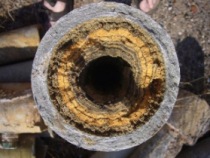Survival analysis of wells
Survival analysis of wells
Certain oil fields have problems concerning sand slides and mineral deposits that cause wells to stop producing.
For the company operating the field, it is important to know the distribution of the time from the start of the well
production until these events occur. This information is used to estimate the lifetime of existing and new wells, and to
determine how many wells to drill.
Censoring
One way to estimate the lifetime of wells is to use only the lifetime of the wells that are observed to fail due to sand slides or mineral
deposits. This will, however, give a very pessimistic estimate, since we ignore many wells that have never had such problems. These wells
are what we call censored data. They have for various reasons not been observed long enough to experience a failure; they are either
still producing, or they are closed for other reasons. Survival analysis is a tool designed to consider censored data by
estimating the lifetime through the failure rate. The failure rate measures the fraction of producing wells that fails within a timeinterval,
where the number of producing wells is continuously updated by removing the censored wells. The model selection is
based on the behavior of the failure rate. I cooperation with Statoil, we have built a lifetime model based on well data from an oilfield.

Contact information
Financing
Statoil


 How to get to NR
How to get to NR Share on social media
Share on social media Privacy policy
Privacy policy